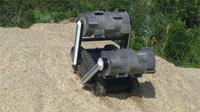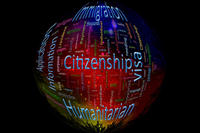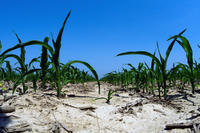-
New clean coal technology provides energy without burning
A new form of clean coal technology reached an important milestone recently, with the successful operation of a research-scale combustion system. The technology is now ready for testing at a larger scale. For 203 continuous hours, the combustion unit produced heat from coal while capturing 99 percent of the carbon dioxide produced in the reaction.
-
-
The humble sea urchin may hold the key to carbon capture
Each year, humans emit on average 33.4 billion metric tons of CO2 — around 45 percent of which remains in the atmosphere. At present, pilot studies for Carbon Capture and Storage (CCS) systems propose the removal of CO2 by pumping it into holes deep underground. This is a costly and difficult process, and it carries with it a long term risk of the gas leaking back out — possibly many miles away from the original downward source. An alternative solution is to convert the CO2 into calcium or magnesium carbonate.
-
-
Novel nanosized antenna arrays key to effective harvesting of solar energy
For years, scientists have studied the potential benefits of a new branch of solar energy technology that relies on incredibly small nanosized antenna arrays that are theoretically capable of harvesting more than 70 percent of the sun’s electromagnetic radiation and simultaneously converting it into usable electric power. A novel fabrication technique could provide the breakthrough technology scientists have been looking for to improve today’s solar energy systems.
-
-
Wastewater from fracking is often highly radioactive
New studies have found that waste from fracking operations can be highly radioactive. A geological survey reported that millions of barrels of wastewater from unconventional wells in Pennsylvania and conventional wells in New York are 3,609 times more radioactive than the federal limit for drinking water, and 300 times more radioactive than a Nuclear Regulatory Commission limit for nuclear plant discharges.
-
-
Climate change threatens public health, safety, economy along U.S. coasts
A new technical study from the U.S. National Oceanic and Atmospheric Agency (NOAA) and the U.S. Geological Survey (USGS) reports that the effects of climate change will continue to threaten the health and vitality of U.S. coastal communities’ social, economic, and natural systems. All U.S. coasts are highly vulnerable to the effects of climate change such as sea-level rise, erosion, storms, and flooding, especially in the more populated low-lying parts of the U.S. coast along the Gulf of Mexico, Mid-Atlantic, northern Alaska, Hawaii, and island territories. The report says that the financial risks associated with both private and public hazard insurance are expected to increase dramatically.
-
-
New bridge construction technologies to shore up U.S. infrastructure
Experts agree that there is an urgent need to construct and repair bridges across the United States. Around 70,000 bridges in the country are considered “structurally deficient” by government standards. New technology could help the United States manage its growing, and aging, infrastructure without breaking the bank or levying high taxes on citizens.
-
-
NASA engineers building sturdy blue-collar mining robot

After decades of designing and operating robots full of scientific gear to study other worlds, NASA is working on a prototype that leaves the delicate instruments at home in exchange for a sturdy pair of diggers and the reliability and strength to work all day, every day for years.
-
-
Extreme rainfall linked to global warming
A worldwide review of global rainfall data has found that the intensity of the most extreme rainfall events is increasing across the globe as temperatures rise. In the most comprehensive review of changes to extreme rainfall ever undertaken, researchers evaluated the association between extreme rainfall and atmospheric temperatures at more than 8,000 weather gauging stations around the world.
-
-
Why some immigrants get citizenship

For immigrants, the path to citizenship in many countries is filled with hurdles: finding a job, learning the language, passing exams. For some people, however, the biggest obstacle of all may be one they cannot help: their country of origin.
-
-
Conflicting cultural identities foster political radicalism
New research suggests that dual-identity immigrants — first-generation immigrants and their descendants who identify with both their cultural minority group and the society they now live in — may be more prone to political radicalism if they perceive their two cultural identities to be incompatible.
-
-
The historical probability of drought

Droughts can severely limit crop growth, causing yearly losses of around $8 billion in the United States. It may be possible, however, to minimize those losses if farmers can synchronize the growth of crops with periods of time when drought is less likely to occur. Researchers are working to create a reliable “calendar” of seasonal drought patterns that could help farmers optimize crop production by avoiding days prone to drought.
-
-
Military electronic devices disappear into the surroundings after use

Electronic devices have become necessary for military operations, but it is almost impossible to track and recover every device. At the end of operations, these devices are often found scattered across the battlefield and might be captured by the enemy and repurposed or studied to compromise DoD’s strategic technological advantage. New DARPA program — Vanishing Programmable Resources (VAPR) program — seeks transient electronics, that is, devices which would maintain the current functionality and ruggedness of conventional electronics, but, when triggered, be able to degrade partially or completely into their surroundings.
-
-
Biometric workshop studied voice, dental, oral standards
The National Institute of Standards and Technology (NIST) hosted a workshop to discuss proposed supplements to the biometric data format standard that support voice recognition, dental and oral data, disaster victim identification, and special data needs for mobile ID applications.
-
-
Projected U.S. water use to increase as climate warms
Despite increases in efficiency, water demand in the United States is likely to increase substantially in the future if climate continues to warm, new projections indicate.
-
-
Laser scanner documents crimes scenes quickly, accurately
The Carlsbad, California police is using a new laser scanner to capture what happened at crime scene. Thenew technology cuts the time it takes to document a crime scene, from the size of the room to the bullet holes in the wall, by up to 80 percent.
-
More headlines
The long view
Autonomous Vehicle Technology Vulnerable to Road Object Spoofing and Vanishing Attacks
Researchers have demonstrated the potentially hazardous vulnerabilities associated with the technology called LiDAR, or Light Detection and Ranging, many autonomous vehicles use to navigate streets, roads and highways. The researchers have shown how to use lasers to fool LiDAR into “seeing” objects that are not present and missing those that are – deficiencies that can cause unwarranted and unsafe braking or collisions.
Tantalizing Method to Study Cyberdeterrence
Tantalus is unlike most war games because it is experimental instead of experiential — the immersive game differs by overlapping scientific rigor and quantitative assessment methods with the experimental sciences, and experimental war gaming provides insightful data for real-world cyberattacks.
Prototype Self-Service Screening System Unveiled
TSA and DHS S&T unveiled a prototype checkpoint technology, the self-service screening system, at Harry Reid International Airport (LAS) in Las Vegas, NV. The aim is to provide a near self-sufficient passenger screening process while enabling passengers to directly receive on-person alarm information and allow for the passenger self-resolution of those alarms.
Falling Space Debris: How High Is the Risk I'll Get Hit?
An International Space Station battery fell back to Earth and, luckily, splashed down harmlessly in the Atlantic. Should we have worried? Space debris reenters our atmosphere every week.
Testing Cutting-Edge Counter-Drone Technology
Drones have many positive applications, bad actors can use them for nefarious purposes. Two recent field demonstrations brought government, academia, and industry together to evaluate innovative counter-unmanned aircraft systems.
Strengthening the Grid’s ‘Backbone’ with Hydropower
Argonne-led studies investigate how hydropower could help add more clean energy to the grid, how it generates value as grids add more renewable energy, and how liner technology can improve hydropower efficiency.
